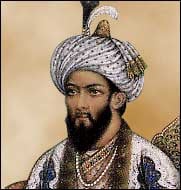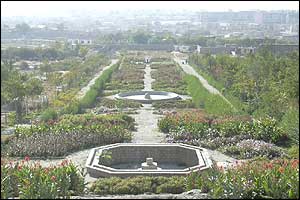Babar: Difference between revisions
No edit summary |
Allenwalla (talk | contribs) m (expanded article) |
||
| Line 1: | Line 1: | ||
[[Image:Baburbhaisahib.jpg|thumb|right|300px|Babur]] | [[Image:Baburbhaisahib.jpg|thumb|right|300px|Babur]] | ||
'''Zahir-ud-Din Babur''' (Babur=Lion) a descendant of the Mongol, Turkic, Persian, and Afghan invaders of Southwest Asia – the Mughals – invaded India in the early 16th century. Babur was the great-grandson of Timur Lenk (Timur the Lame, from which the Western name Tamerlane is derived), who had invaded India and plundered Delhi in 1398 and then ruled over a short-lived empire based in Samarkand (in modern-day Uzbekistan) that united Persian-based Mongols (Babur's maternal ancestors) and other West Asian peoples. | |||
Babur was driven from Samarkand and initially established his rule in Kabul in 1504. Having grow up with stories of the easy riches to be gained in India he made several raids into the Punjab and India. Now with a firm base close to the passes into India he became determined to expand his kingdom eastward into the Punjab. But as fate would have it before he invaded, an invitation from an opportunistic Afghan chief in Punjab, who wished his help in overthrowing Ibrahim Lodi, the ruler of the Delhi Sultinate (1517-26), brought him to the very heart of Delhi and his desire to build a mighty kingdom. | |||
[[Image:Gardenebabur.jpg|thumb|right|300px|Bagh - e - Babur]] | [[Image:Gardenebabur.jpg|thumb|right|300px|Bagh - e - Babur]] | ||
Babur, a seasoned military commander, entered India in 1526 with his well-trained veteran army of 12,000 to meet the sultan's huge but unwieldy and disunited force of more than 100,000 men. Babur defeated the Lodi sultan decisively at Panipat (in modern-day Haryana, about ninety kilometers north of Delhi). Employing | Babur, a seasoned military commander, entered India in 1526 with his well-trained veteran army of 12,000 to meet the sultan's huge but unwieldy and disunited force of more than 100,000 men. Babur defeated the Lodi sultan decisively at Panipat (in modern-day Haryana, about ninety kilometers north of Delhi where several decicive battles have been won and lost). | ||
Employing something never seen before in India——gun carts, moveable artillery, and superior cavalry tactics, Babur achieved a resounding victory. A year later, he decisively defeated a Rajput confederacy led by Rana Sangha. | |||
In 1529 Babur routed the joint forces of Afghans and the sultan of Bengal but died in 1530 before he could consolidate his military gains. He left behind as legacies his memoirs (Babur Namah), several beautiful gardens in Kabul, Lahore, and Agra, and destroyed many more Hindu Mandirs from the mountains of Jammu and Kashmir to the East across India. | |||
His son Humayun, the first to gain from a Rajput Raja the famed diamond——later to be called the Koh-i-noor, would soon be forced to leave India only to return to build an even greater kingdom. His son Akbar and his descendants would fulfill Babur's dream of establishing a Mughal empire in Hindustan. Leaving behind in the end, as had their ancestor, a spledid history of beautuful arts and Architecture along with an equally brutal history of destruction and death. | |||
Revision as of 07:48, 6 February 2008
Zahir-ud-Din Babur (Babur=Lion) a descendant of the Mongol, Turkic, Persian, and Afghan invaders of Southwest Asia – the Mughals – invaded India in the early 16th century. Babur was the great-grandson of Timur Lenk (Timur the Lame, from which the Western name Tamerlane is derived), who had invaded India and plundered Delhi in 1398 and then ruled over a short-lived empire based in Samarkand (in modern-day Uzbekistan) that united Persian-based Mongols (Babur's maternal ancestors) and other West Asian peoples.
Babur was driven from Samarkand and initially established his rule in Kabul in 1504. Having grow up with stories of the easy riches to be gained in India he made several raids into the Punjab and India. Now with a firm base close to the passes into India he became determined to expand his kingdom eastward into the Punjab. But as fate would have it before he invaded, an invitation from an opportunistic Afghan chief in Punjab, who wished his help in overthrowing Ibrahim Lodi, the ruler of the Delhi Sultinate (1517-26), brought him to the very heart of Delhi and his desire to build a mighty kingdom.
Babur, a seasoned military commander, entered India in 1526 with his well-trained veteran army of 12,000 to meet the sultan's huge but unwieldy and disunited force of more than 100,000 men. Babur defeated the Lodi sultan decisively at Panipat (in modern-day Haryana, about ninety kilometers north of Delhi where several decicive battles have been won and lost).
Employing something never seen before in India——gun carts, moveable artillery, and superior cavalry tactics, Babur achieved a resounding victory. A year later, he decisively defeated a Rajput confederacy led by Rana Sangha.
In 1529 Babur routed the joint forces of Afghans and the sultan of Bengal but died in 1530 before he could consolidate his military gains. He left behind as legacies his memoirs (Babur Namah), several beautiful gardens in Kabul, Lahore, and Agra, and destroyed many more Hindu Mandirs from the mountains of Jammu and Kashmir to the East across India.
His son Humayun, the first to gain from a Rajput Raja the famed diamond——later to be called the Koh-i-noor, would soon be forced to leave India only to return to build an even greater kingdom. His son Akbar and his descendants would fulfill Babur's dream of establishing a Mughal empire in Hindustan. Leaving behind in the end, as had their ancestor, a spledid history of beautuful arts and Architecture along with an equally brutal history of destruction and death.
| These articles deal with Mughal Empire |
|
Babur (1526-30) -|- Humayun (1530-56) -|- Akbar (1556-1605) -|- Jahangir (1605-27) -|- Shah Jahan (1627-58) -|- Aurangzeb (1658-1707) |


